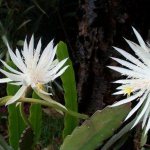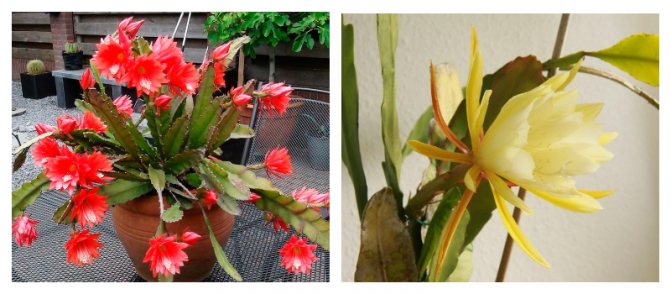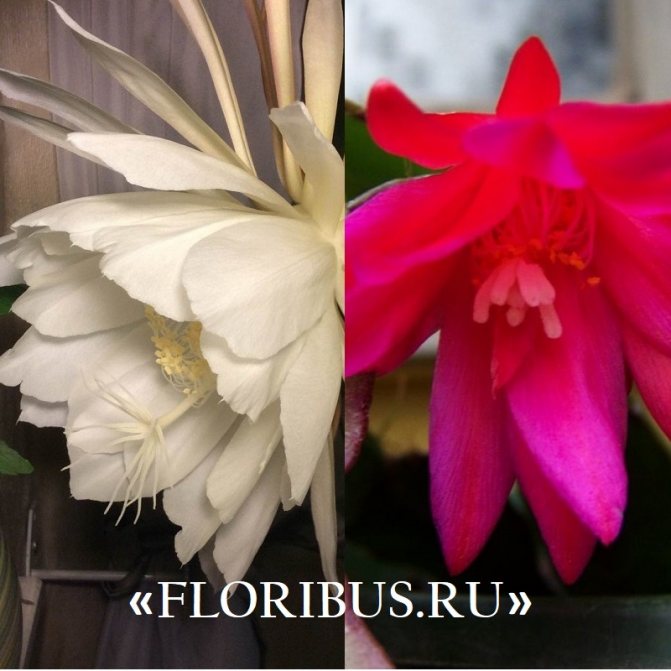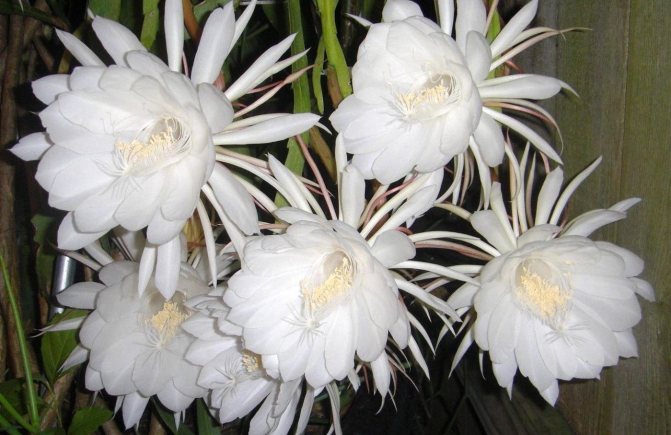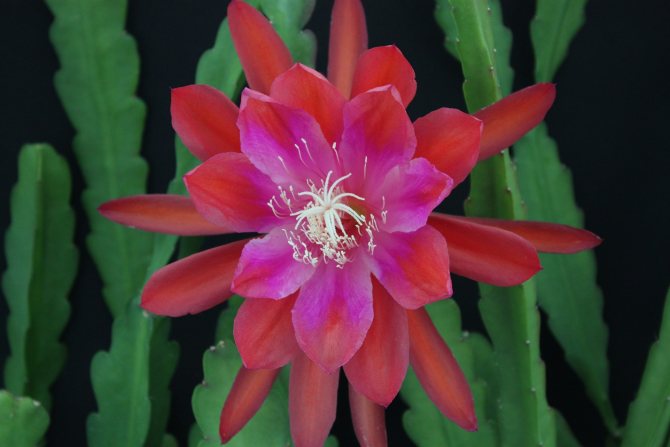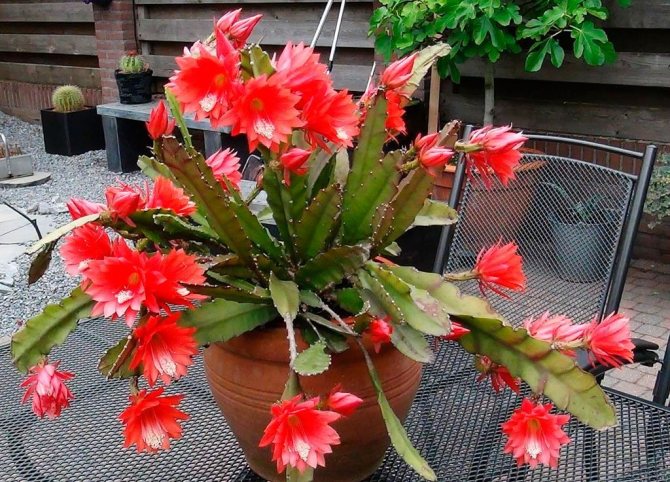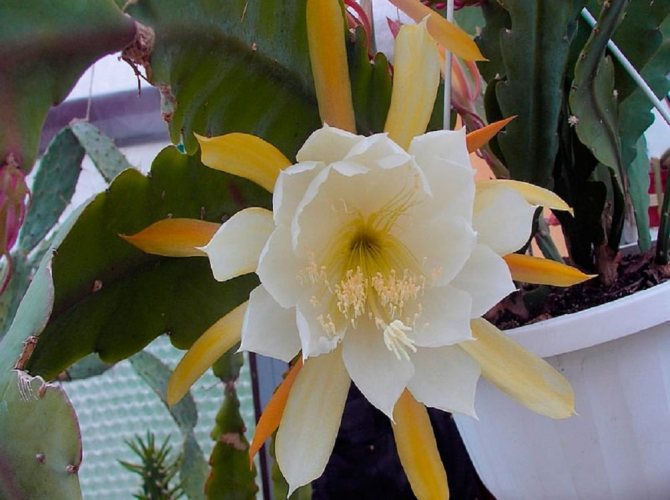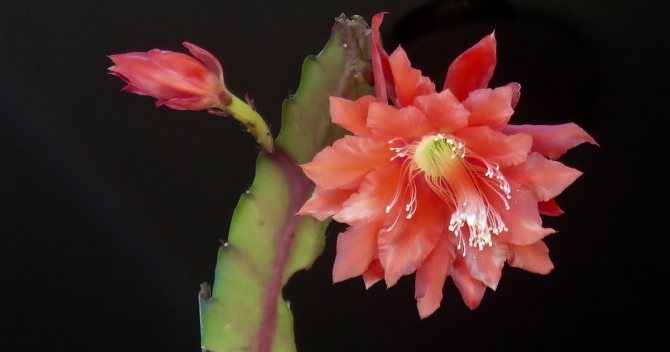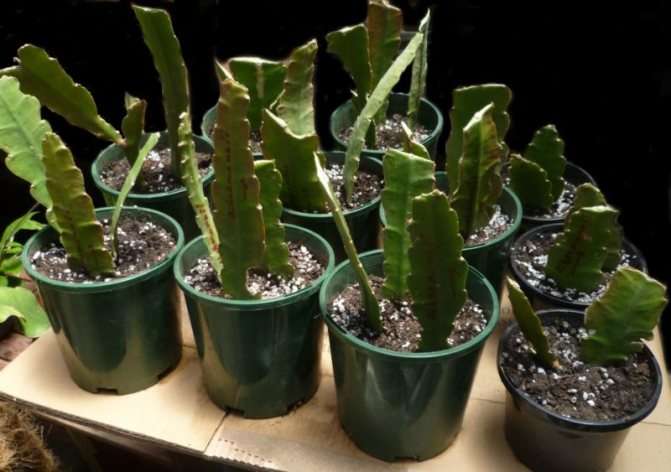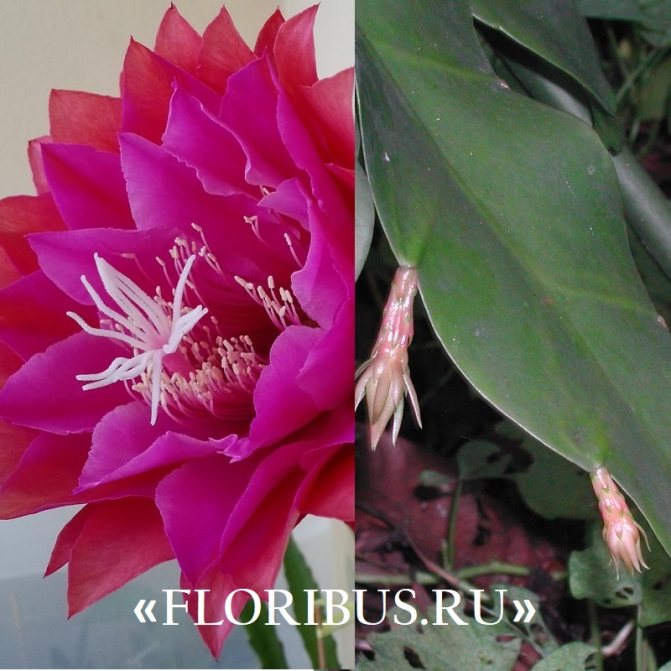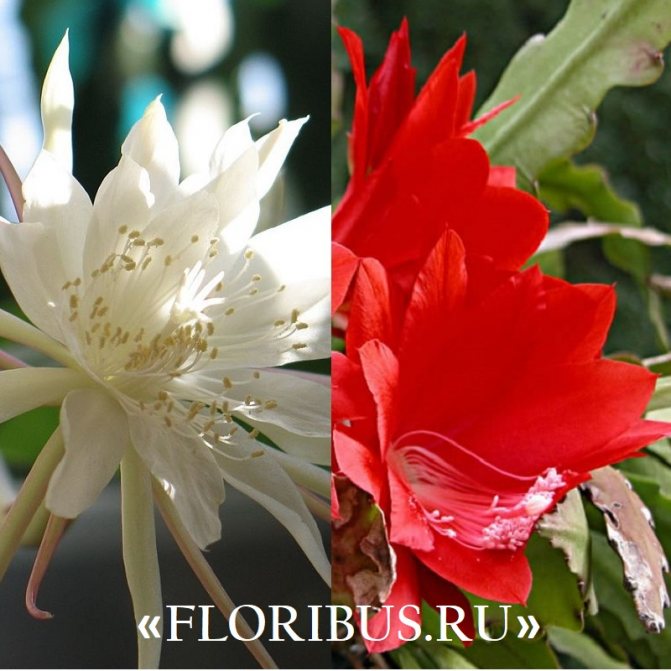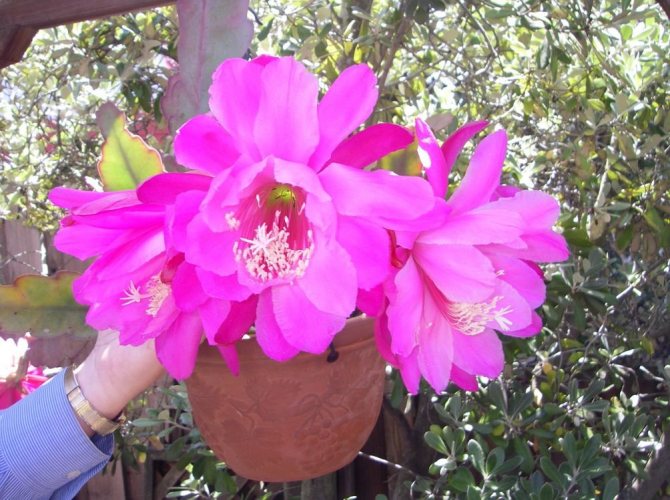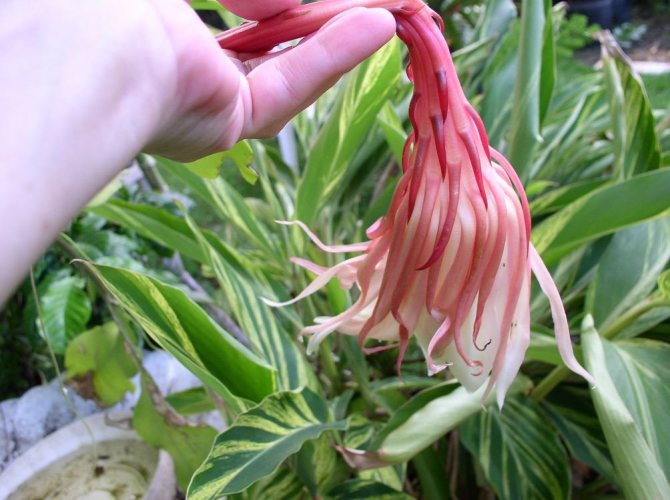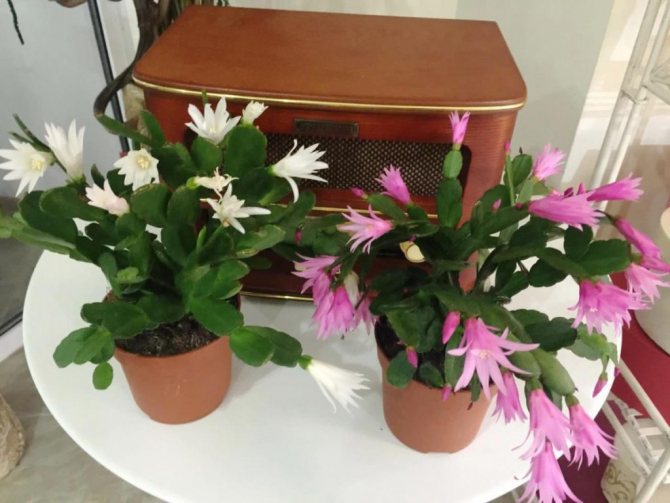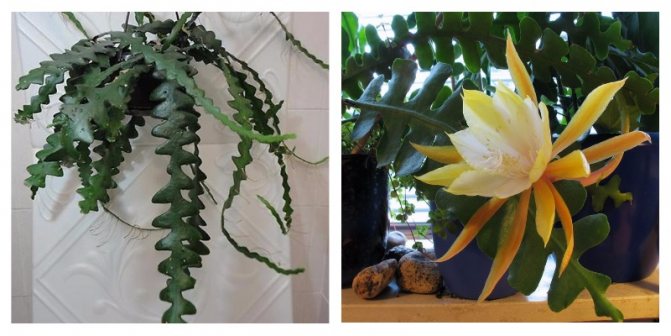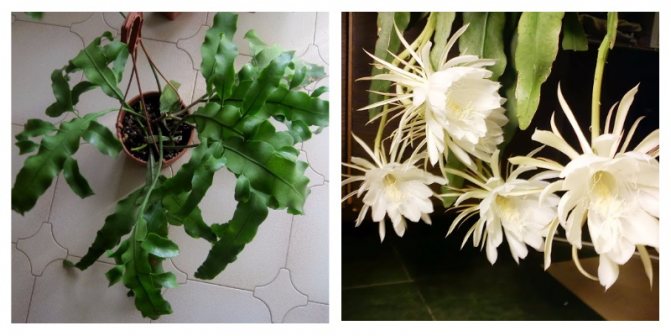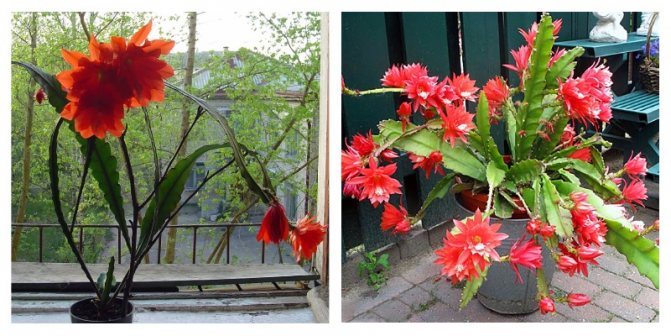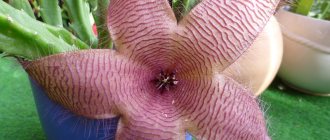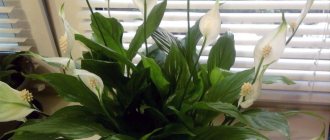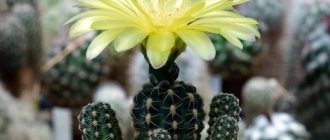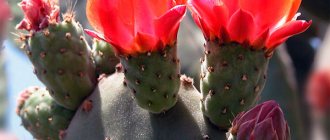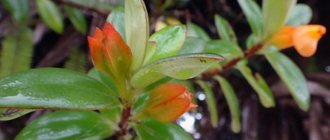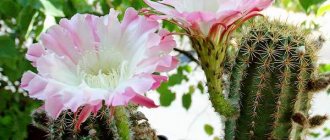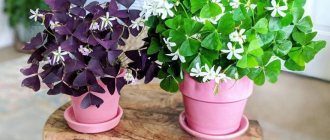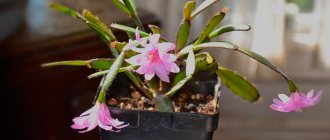Description of the epiphyllum
Epiphyllum (Epiphyllum), phyllocactus, it is also a forest cactus - a succulent plant belonging to the Cactaceae family, Distributed in the natural environment from Mexico to the tropical belt of America. In 1812, Adrienne Haworth discovered and described the plant.
The epiphytic cactus has long branched stems, they can be creeping or drooping. Stems are tetrahedral or flat. Due to the appearance, the stems are mistaken for leaves, but this is not the case, the plant does not have leaves.
The flowers are large (capable of reaching a length of 40 cm, can open during the day and at night), funnel-shaped, the color is mainly white, but there are forms with cream, yellow, pink, red flowers. The flowers are not only beautiful but also fragrant. After flowering, an edible fruit appears that has a banana-pineapple-strawberry flavor. It is large, reddish in color, often prickly.
Phyllocactus is very popular in home cultivation as an ampelous plant.
Similar plants
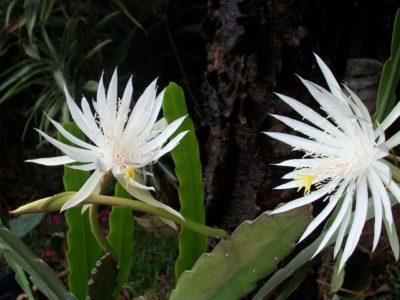
It is easy to confuse Epiphyllum Anguliger with Epiphyllum hookeri. However, the latter plant has a snow-white flower and a different form of shoots.- Also, his Guatemalan tribesman is similar to Anguliger. It is equipped with the same parts as Anguliger, but has an appendage in the form of wide green spreading leaves.
- Epiphyllum laui is like Anguliger, but has a much brighter and redder flower of the former.
- Some inexperienced gardeners may confuse Anguliger even with Hatiora, relying solely on the distant similarity of the Hatiora segments with the shape of the Anguliger stem.
- Also, sometimes Schlumberger is mistakenly related to the Forest Cactus. After all, these are cacti, exotic forms and with variegated flowers. But do not forget that the type of flowers discussed in this article has a lot less, but they are larger, and the stems of this cactus are integral.
Epiphyllum is unusual and unpretentious. It is especially beautiful during flowering and is suitable for decorating a garden, balcony and any interior. In our articles we will tell you about the care, reproduction and types of this exotic. For excellent living conditions and attentive attitude, the plant will thank you with abundant flowering.
There are amazingly many beautiful plants in nature. Succulents are no exception. In this article, one of the representatives of the Epiphyllum species was considered. I am sure that everyone who is familiar with this plant will note its indispensability in their home collection.
If you find an error, please select a piece of text and press Ctrl + Enter.
How to care for epiphyllum at home


Epiphyllum flower how to care at home photo
Site selection and lighting
To make the epiphyllum bloom, you should place the pot with the plant on an east or west windowsill. Lighting is needed bright, but diffused. In summer, it is advisable to take phyllocactus outside - but be sure to protect it from direct sunlight, especially at noon.
Air temperature
The optimal temperature regime for a plant in the warm season is 20-25º C. During the rest period (November-February), the temperature should be lowered to 10-15º C.
Watering
The plant needs regular watering: more frequent in summer, less often in winter. Water as soon as the topsoil dries out in the pot. With a cool winter, watering can be stopped altogether.With the onset of spring, resume and gradually increase watering. It is enough to spray the plant only on the hottest days. For watering and spraying, use settled water at room temperature.
Top dressing
Epiphyllum requires a sufficient supply of nutrients. In spring and summer, it is necessary to apply a fertilizer solution for cacti to the soil twice a month. During the budding period, feed with a mullein: dilute 1 part of the fertilizer with 10 parts of water. At the end of flowering, apply top dressing once every 2 weeks, alternating organic matter with mineral nitrogen fertilizers. There is no need to feed during the rest period.
Pruning
Trim the epiphyllum periodically. Faceted or round stems must be removed (they never bloom), and flat stems must be shortened. Flowers appear on flat stems that have grown over the past year, on older stems that have already bloomed, buds will no longer appear, but to keep the plant alive, such stems can be removed after 2-3 years. Also remove twisted stems, stems growing into the bush and on which cork formations appear. Treat the sections with a fungicide.
Features of seasonal care
During the year, the plant experiences periods of active growth and relative dormancy. In the fall, all vital processes are inhibited, during the winter the flower rests. During this period, it is desirable to provide him with cool air (+ 10..15 ° C). There is no need to highlight the plant additionally. But if it hibernates in a warm room, you will have to turn on the backlight in the evening. Water the flower 1-2 times a month. It is necessary to resume abundant watering in the spring, gradually increase them. There is no need to feed the cactus in winter.
How to make epiphyllum bloom and why it doesn't bloom at home
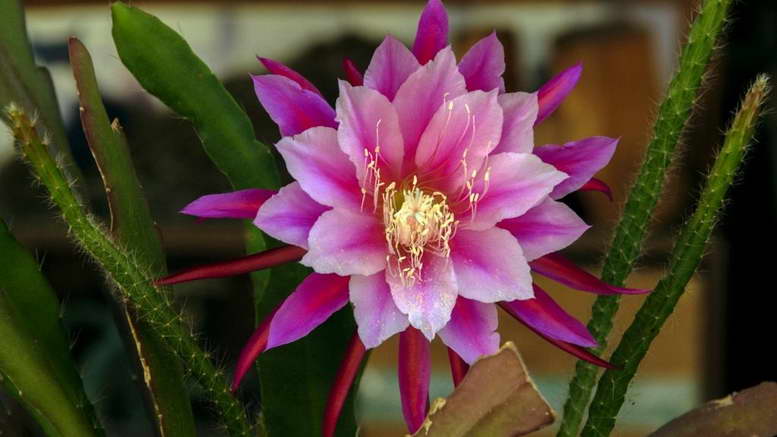

Epiphyllum indoor reproduction and home care photo of flowers
With the beginning of the formation of buds, the plant categorically cannot be rearranged or even simply rotated the pot with the plant, otherwise the phyllocactus will drop the buds. Flowers open in turn and delight everyone during the week. In some species and varieties, flowering occurs twice a year: in spring and autumn. Water abundantly during the flowering period, place the pot with the plant on a tray so that excess water flows out and does not stagnate in the roots. Don't forget about top dressing.
The reasons for the lack of flowering are as follows:
- Insufficient lighting
- Abundant watering during a cool winter
- Wintering in warm conditions
- Excess nitrogen in the soil
Flowering occurs only when the plant is kept in conditions that are comfortable for it. Check if there is enough light, moisture and the correct feeding regime (you should stop applying nitrogenous fertilizers). Be sure to keep the air temperature at 12 ºC during the dormant period (November-February). Under these conditions, the plant will surely thank you with flowering next season.
Bloom
Bud formation occurs after the end of the dormant period, in early spring. Also, the plant shoot thickens and the active growth phase begins. It is important not to disturb the flower at this time, as this can damage the inflorescences. Usually, flowers last up to five days.
Fertilizing, spraying and reasonably generous watering of the cactus during this period will not be superfluous. Then, strikingly beautiful yellow flowers will be even more attractive.
If you are interested in learning how to make the epiphyllum bloom and what varieties of this plant can delight you with beautiful flowers, then we suggest reading this article.
Epiphyllum transplant
Young, fast-growing phyllocactus require annual replanting in the spring. Transplant adult specimens as needed (when roots begin to peek out of the drain holes), do this after flowering. The container needs a wide and not deep one. A ceramic or heavy-duty plastic pot works best.
At the bottom, be sure to lay a drainage layer made up of pieces of foam, expanded clay, pebbles. As a soil, a substrate for succulents or cacti is suitable. The following soil mixture is suitable: 4 parts each of leaf and sod land with the addition of 1 part of coarse sand, charcoal and fibrous peat. After transplanting, place in partial shade, water in moderation.
How to care when growing a plant at home?
How is a cactus taken care of? To do this, observe the following recommendations:
- It is important to choose the right plant. For this, it is inspected. Signs of health are dense and elastic stems of intense green color. There should be no stains on it. Shopping should be avoided even if there is a cobweb in the container under the plant. Shoots should not be dry, lethargic. They should not be damaged, since all this is a sign of the presence of a disease. You should not buy an epiphyllum even if it has bud ovaries. They may fall off when transporting the pot. Places of ovary formation are not viable. That is, the beginning of flowering, in this case, will have to be expected for two years;
- It is recommended to transplant the cactus in the spring months. Therefore, if it is purchased in winter, it is worth waiting with this procedure;
- The transplant is carried out in a cramped container, since the root system must grow over its entire space. The old substrate needs to be removed;
- For the prevention of diseases, during transplantation, it is necessary to treat the root system with charcoal;
- After the transplant, watering is not performed for a couple of days;
- When is the re-transplant performed? This can be done after the flowering period. Flat and wide containers are suitable for this. You cannot take high trays with a large volume for the plant. The root system of the cactus is rather weak, and therefore it should fill the entire space. Otherwise, the soil will acidify. This procedure is not required annually. It is carried out as needed;
- Before transplanting, it is required, two to three days before the procedure, not to water. This helps to remove old soil from the root system;
- Drainage must be placed at the bottom of the container. It does not allow the formation of stagnant moisture;
- The ground must be sterilized before planting. This is required in order to remove all potentially harmful elements from it. This is done by means of a water bath;
- The cactus container is installed in a dark place, as it must adapt to new conditions. Extraneous influences should be limited;
- Watering, after the process of transplanting into a new pot, is allowed only in moderate amounts;
- The formation of a beautiful bush system is an important factor when growing an epiphyllum. To do this, it is required to periodically cut off faded shoots from it, old branches on which buds will no longer appear. When pruning, shoots with three edges are removed, since they do not bloom. This is necessary so that the plant does not waste its resources on them;
- It is necessary to pinch large shoots, as this contributes to the aesthetics of the bush. New shoots gradually begin to appear on them, where flower buds are formed;
- The plant loves a lot of light and warmth. However, you should not allow direct sunlight to hit it. The optimal temperature regime is 24-25 degrees.
How to water the plant? It relates fairly well to increased moisture levels. Intensive watering is carried out during the summer months, as well as during the flowering period. How much water is required? Moderation is needed here. Epiphyllum should not be poured, but the upper surface of the earth should not dry out. In winter, watering can be reduced to a minimum. In severe frosts, the plant does not require water.
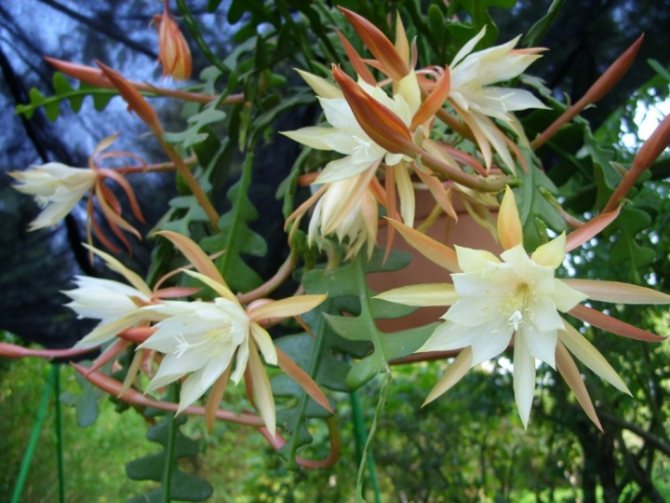

Pests and diseases and epiphyllum
Pests
The succulent stems of the plant attract the attention of sucking insects: aphids, scale insects, spider mites, mealybugs.They not only provoke a wilted plant species, but scale insects and aphids are carriers of viral diseases. First, remove the pests mechanically: moisten a sponge or cotton swab with soapy water and wipe the stems of the plant. Then carry out the insecticide treatment, repeating after a week.
Consider plant diseases
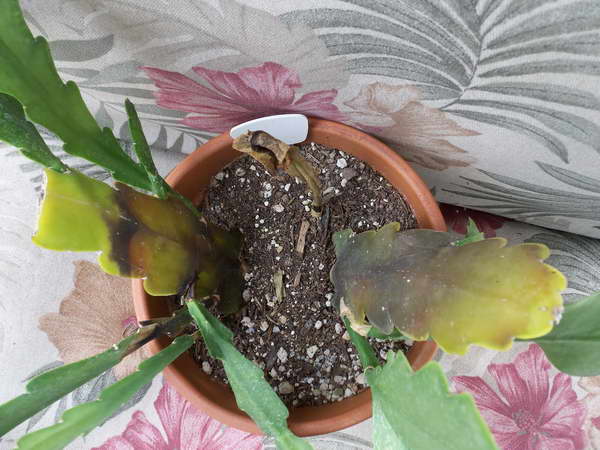

Epiphyllum diseases - black rot photo
Black rot - the stems of the plant are covered with black shiny spots. It is necessary to remove the affected areas. Treat the plant with Fundazole.


Epiphyllum diseases - rust photo
Rust appears as red spots on the stems. This happens for a number of reasons: sunburn, falling of water droplets on the stems when watering, excessive watering at a cool air temperature. It is necessary to treat the plant with Topaz.


Mosaic disease on the epiphyllum photo
Mosaic disease is a viral disease that is fatal to a plant. At the first symptoms, quarantine the plant, remove all damaged areas, treat the green mass and soil with phytosporin several times at intervals of 10 days. If the disease progresses, destroy the plant so that there is no contamination of neighboring specimens.


Anthracnose on epiphyllum photo
Anthracnose - light brown spots on the stems. Actions: cut out the affected areas, treat with a fungicide.
Fusarium - rotting of the root system, manifested by the change of the green color of the stems to reddish, brown. The roots can rot not only because of this disease, but also when making mistakes in care (excess moisture, watering with cold water, overheating due to prolonged exposure to the sun). There is always one escape route - an emergency transplant. Remove damaged roots, treat the sections with a fungicide. After transplanting, it is best not to water for a while, then adjust the watering.
Care errors and their consequences:
- From bright light or lack of watering, the stems dry out and wrinkle
- If the root system is damaged during transplantation, the stems will begin to dry out and die off.
- The shoots will crack from the excess of nutrients.
Possible difficulties
If the content is incorrect, the epiphyllum suffers from fungal diseases (black rot, anthracnose, fusarium, leaf rust). All these diseases are characterized by a slowdown in growth, the appearance of weeping spots on the leaves and trunk of various colors, as well as an unpleasant, putrid odor. It is necessary to transplant the diseased plant, cut off the damaged areas and treat them with crushed charcoal. Spraying with a fungicide is also carried out.
The most common parasites for the epiphyllum are spider mites, aphids, scale insects and mealybugs. They are fought with the help of bathing and treatment with insecticides ("Confidor", "Mospilan", "Aktara", "Biotlin").
Post Views: 1
Growing epiphyllum from seeds
Epiphyllum seeds photo
Seed and vegetative (by dividing the bush, stem cuttings) reproduction is possible
Propagating phyllocactus by seed is quite simple. It is necessary to fill the bowls with the succulent substrate, moisten the soil and distribute the seeds over the surface. Cover crops with foil, maintain air temperature within 20-23ºC. Do not forget to ventilate daily for 30 minutes.
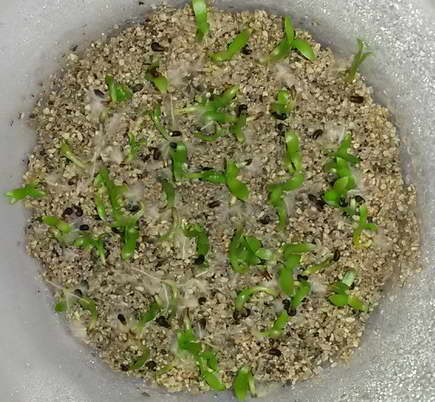

Epiphyllum from seeds photo of seedlings
With the emergence of shoots, remove the film completely. The sprouts will look like small faceted cacti with thorns - over time they will become flat and the thorns will fall off. Expect flowering years 4-5.
Cactus diseases
What are the diseases of the epiphyllum? Among his main ailment, a viral mosaic can be noted. Her symptoms:
- The appearance of many small spots on the stems of a light shade;
- Drying of the ends of the shoots;
- Falling buds.
This is a viral disease, and it is extremely difficult to cure. It is easier to destroy the plant so that the virus does not spread to other flowers. Among the common pests of the epiphyllum are the scale insect, mealybug, and aphids.If the flower is grown outdoors, slugs or annular corky specks may develop. Such expanding spots are caused by fungal-type infectious processes. For example, it can be fusarium.
Growing an epiphyllum is a complex process. With him, it is important to choose the right soil, think over the lighting, regularly water and fertilize. But the cactus will delight you with its intense flowering, which will decorate the house. This is a rather exotic plant that looks unusual in the interior.
Dividing the bush
Divide the bush when transplanting an adult plant. Remove the phyllocactus from the pot, divide it into parts so that each division has healthy, young stems and strong roots. Cut off dry, rotten areas, treat with a fungicide. Plant in separate pots with drainage and substrate suitable for growing epiphyllum. For adaptation, partial shade and minimal watering are required.
A place
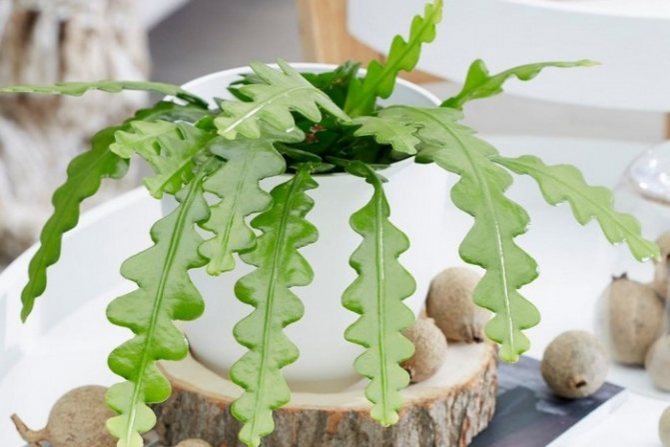

In summer, epiphyllum is grown in a bright place, without direct access to sunlight at midday. It will feel good on the windowsill of the northeast or southeast side. The temperature behind the glass depends on the season and the frequency of opening the window. Whether the location is correct can be determined by the condition of the plant. If corking appears on the shoots - the first sign of excess light, which causes a rise in temperature when the air is too dry. Another sign is a change in the color of the shoots towards a brownish-red color (the appearance of anthocyanins) indicates an excess of light, manifests itself when the plant is exposed to the street in the wrong place. The appearance of elongated shoots suggests a lack of light. We'll have to tinker with the plant before we determine the right place.
Epiphyllums easily shed their buds if they are moved when the flower buds have already formed, as small changes in the environment provoke the buds to fall off.
Propagation of epiphyllum by cuttings


Epiphyllum cuttings photo
Carry out cuttings from the beginning of April to the end of May.
- Divide the stems into pieces 10-13 cm long.
- Make a wedge-shaped cut along the bottom, place the cutting in a dry empty container for a couple of days to dry the slices, then plant it in the ground, deepening 1 cm.
- Soil composition: 3 parts of light soil with the addition of 1 part of perlite, after planting, sprinkle the surface of the soil with a layer of sand (about 2 cm thick).
- Root in the shade, start watering 2 days after planting.
Cactus, but does not grow in the desert
Epiphyllum is a forest cactus. Desert relatives are only reminiscent of the small and rare needles that the plant has. Moreover, the fact that the epiphyllum has no leaves at all, only their rudiments. But the stem is, flat with angular edges.
This leaf-like stem misled the English botanist Adrian Haworth. More than two hundred years ago, in 1812, a scientist discovered a new species of semi-shrub plants in the tropics of South America. He was lucky enough to see luxurious flowers bloom at the ends of the epiphyllum stems. Haworth described the plant and named it Epi phyllum, which in Greek means "on top of the leaf." Later it turned out that the botanist was mistaken: the epiphyllum has no leaves.
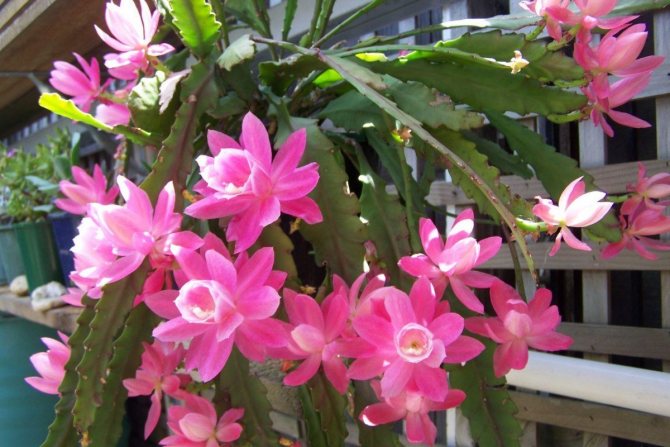

The plant has stems and flowers, but no leaves.
Epiphyllum at first glance is rather ordinary-looking, even sloppy. Rigid ribbed flower stems, reaching a length of 70 cm, bulge in all directions. But once the flowers bloom, the slob transforms into a handsome man. Luxurious flowers (in some species they reach 18 cm in diameter), resembling a funnel, are striking in their beauty, and sometimes they smell wonderful... Delighted fans of the epiphyllum called their favorite "cactus-orchid" for the beautiful flowers.


Epiphyllum will bloom not only on the windowsill, but also in the wall pots
Try it! In the wild, the epiphyllum bears fruit. A domesticated plant can also bear fruit.But for this you have to do the pollination of the flower. Anyone who has successfully completed the work of a bee will harvest prickly crops, the size of a plum of edible fruit. Inside they are juicy, they taste like pineapple and strawberries at the same time.
Choosing a strong seedling
Caring for the plant will be easier if you are careful when purchasing it. The epiphyllum should look like this:
- stems are rich green, elastic and dense;
- no spots on stems, broken or sluggish shoots;
- the pot is clean, no cobwebs or mold;
- no buds.
Important! Resist the temptation to buy a set-bud epiphyllum. They will fall off during transport. And on these areoles, buds will no longer appear, since they bloom only once in a lifetime. This means that you will not achieve flowering from this plant for the next two years.
Types and varieties of epiphyllum with photos and names
Consider the popular types and varieties of epiphyllum in cultivation.
Epiphyllum oxypetalum aka Epiphyllum oxypetalum


Epiphyllum oxypetalum aka oxypetalum Epiphyllum oxypetalum photo
The plant is large, reaches a height of about 3 m. Shoots are rod-shaped, flat, wavy along the edges, lignified in the lower part. The stem is 10 cm wide. The flowers are huge: up to 20 cm long and about 18 cm in diameter. The color is white, hybrid forms can have different colors.
Epiphyllum anguliger or angular Epiphyllum anguliger
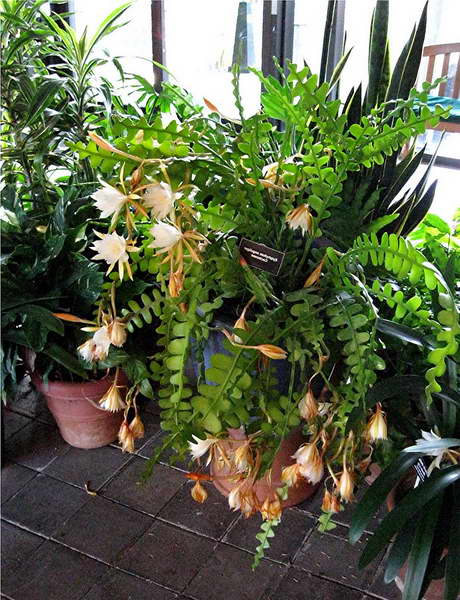

Epiphyllum anguliger or angular Epiphyllum anguliger photo
The bush is highly branched. The lower stems are rounded, sometimes triangular, woody, the upper ones are flat or triangular. The stem is about 1 m long and 4-8 cm wide. The color is dark green. The flowers are large (4-8 cm in diameter), painted in bright red.
Hooker's Epiphyllum Epiphyllum hookeri
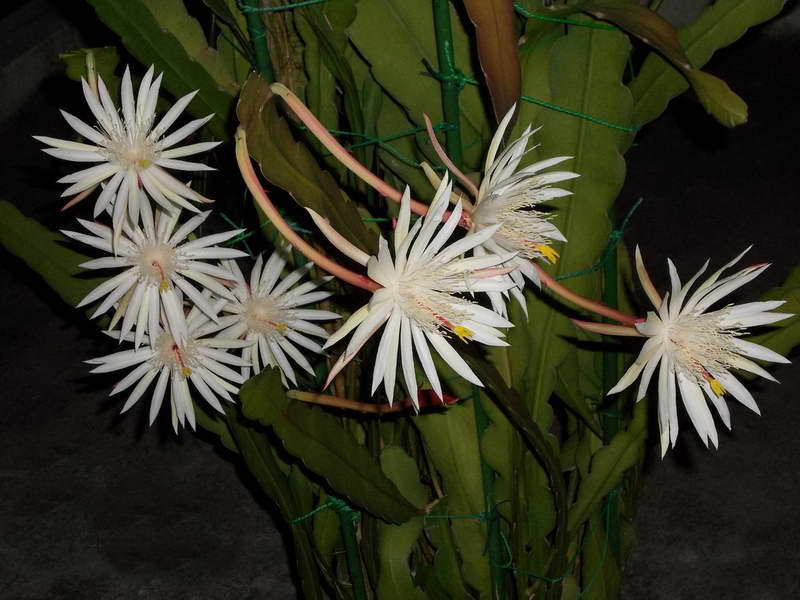

Hooker's Epiphyllum Epiphyllum hookeri photo
Originally from Cuba. It has long stems, which, under the weight of their own weight, bend in an arc and fall to the ground. The flowers are white.
Epiphyllum serrated Epiphyllum crenatum
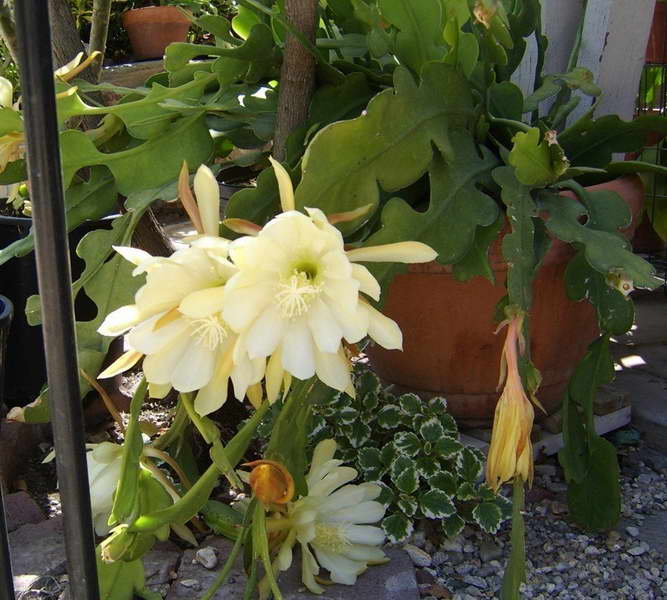

Epiphyllum serrated Epiphyllum crenatum photo
Semi-epiphytic plant with stems 70 cm long and up to 10 cm wide, their color is bluish-green. The stems are carved along the edges. The diameter of the flower is 15 cm. The color depends on the hybrid form.
Epiphyllum phyllanthus Epiphyllum phyllanthus


Epiphyllum phyllanthus Epiphyllum phyllanthus
Originally from South America. Shoots reach a length of 1 m, secondary flat stems are 25-50 cm in length. The flowers are pink, the diameter of the corolla is 15-18 cm.
Epiphyllum guatemalan Epiphyllum guatemalense


Epiphyllum guatemalan Epiphyllum guatemalense photo
The stems are a chain of successively connected parts, similar in shape to oak leaves. Each “link” is 5 cm long. Flowers have a variety of colors.
Epiphyllum Thomas Epiphyllum thomasianum
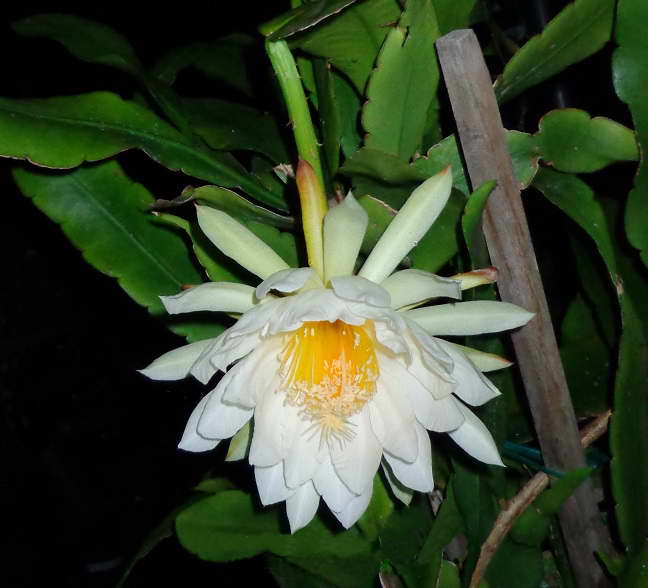

Epiphyllum Thomas Epiphyllum thomasianum photo
In the natural environment, the stems reach a length of up to 4 m, in room conditions they are limited to 70 cm. Flowers with a diameter of 25 cm are white, the core is yellow.
Epiphyllum Ackerman Epiphyllum ackermanii


Epiphyllum Ackerman Epiphyllum ackermanii photo
Hanging stems, flat serrated processes are located at the level of 4-7 cm from the base. Flowers of a fiery red hue, they are attached to thin pedicels.
Epiphyllum Lau Epiphyllum laui
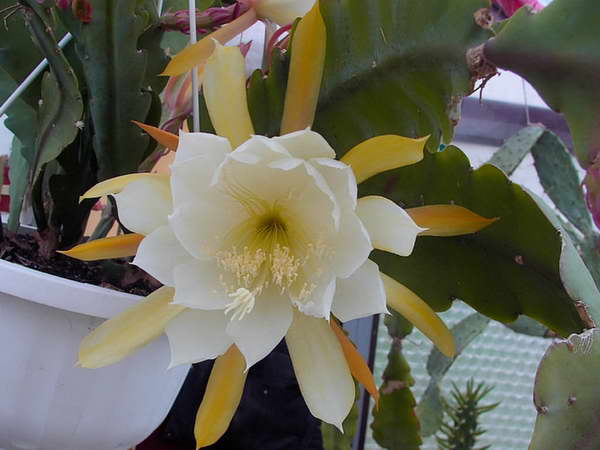

Epiphyllum Lau Epiphyllum laui photo
The main stems of the plant are 2 cm in diameter, the lateral ones are about 7 cm. The shoots are covered with hair-like needles about 4 mm long, their color is yellowish-brown. Flowers of a white-cream shade open in the evening and flaunt within 2 days.
Popular hybrid forms of epiphyllum:
- A hybrid bred by Frank Nunn (unnamed) - the middle of the flower is painted white, gradually turns into light pink, and the edges are bright purple.
- King Midas - stems are dark green, up to 1.5 m long. Large flowers with a diameter of about 16.5 cm are yellow-orange, almost gold in color.
- Just Prue - has flowers with a diameter of 12-16 cm, color: light pink middle turns into dark pink edges.
- Epiphyllum Johnson - dark scarlet flowers.
- Wendy Mae - the color of the flowers is bright crimson.The shape of the corolla is unusual: in the middle, the petals are short, rounded, and the outer ones are long, have pointed edges.
- Jennifer Ann - has bright lemon-colored flowers.
- Martin - the stems are falling, consist of oval-shaped segments. The flowers are funnel-shaped, with a light yellow center passing over the edges of a reddish color. The bloom exudes a pungent aroma.
Signs and superstitions
All the signs that people associate with cacti fully apply to Epiphyllum, and to believe these signs or not is the business of every person:
- A blooming cactus promises an addition to the family, and for the lonely it promises a meeting with the betrothed;
- You cannot give a cactus to a loved one - this promises separation;
- The cactus of unmarried women drives away suitors from them;
- The cactus keeps the house from any troubles.
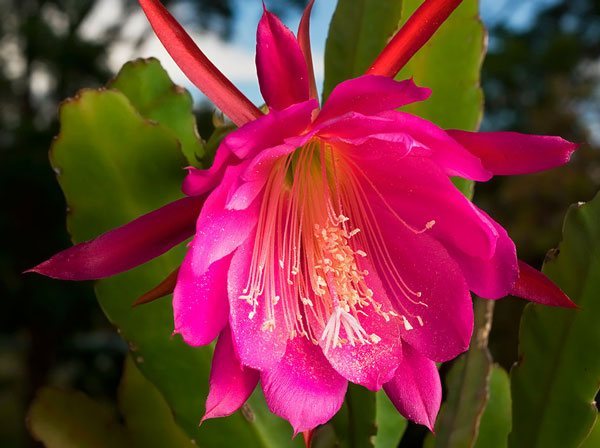

The huge variety of species and varieties of Epiphyllum, its relatively easy nature in terms of maintenance and care, and the splendor of flowering plants attract more and more flower growers to the cultivation of this particular genus of cacti. And for its medicinal properties, it deserves special respect and love.
Three ways of breeding
Epiphyllum is propagated by seeds, cuttings and layering. Growing from seed is suitable for the most patient growers. Such cacti bloom only after 5 years. The other two methods give faster results.
How to germinate seeds
Stock up on seeds first. Get ripe fruits from your own or someone else's epiphyllum, cut them, remove the seeds, dry them. Then wait for spring and start the sowing campaign:
- Take a container, pour drainage on the bottom, sand on top.
- Moisten the surface, sprinkle the seeds, cover them with sand.
- Cover the container with glass.
- Place in a warm and well-lit place.
- Ventilate for 15 minutes once a day, wipe off condensation. Keep the soil moist.
The young growth of the epiphyllum is prickly and looks like triangular cacti. Growing up, the stems acquire a flat shape and lose thorns.
How to root cuttings ("leaves") in the ground
For the propagation of epiphyllum by cuttings, it is better to take plastic dishes, it keeps moisture longer.
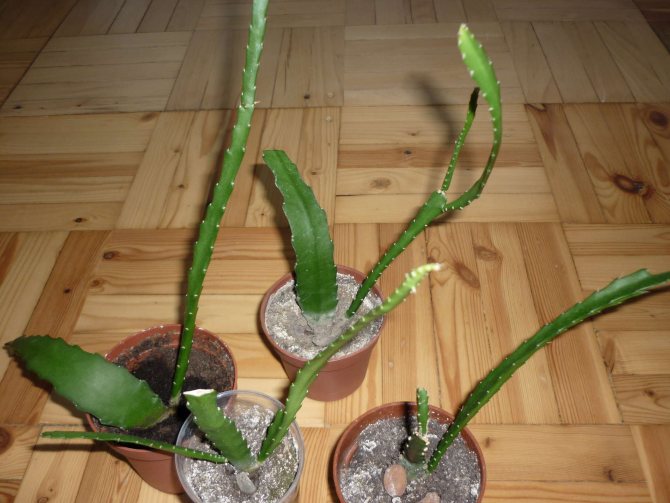

Plant cuttings of phyllocactus in small plastic pots
Engaged in cuttings in April or after flowering, at the end of summer.
Progress:
- A piece of about 12 cm is cut from the stem. Please note that the stem chosen for grafting should not be narrowed at the bottom, such ones take root worse.
- Cut the bottom of the cutting with an angle.
- Rid the workpiece of excess juice by placing it in a container for an hour.
- Dry the cutting for 24 hours.
- Dip the dried cutting into the soil to a depth of 1 cm.
- The stalk does not need to be watered until it takes root: watering can cause rotting. Moisten the soil surface with a spray bottle.
- When the stalk gives a root, it is transplanted into a small pot, 7-8 cm in diameter.
How to get air layers to give roots
Examine your epiphyllum carefully. At a sufficiently high humidity, aerial roots form on the stems of the plant. They will help you get a new flower. Found - take action:
- Bend the stem with roots to the soil and deepen a little.
- After some time, the stem will develop roots. Separate part of the stem with roots and dry slightly.
- Transplant the layer into a new pot ...
- ... And wait for the roots to fill the entire space. Then your cactus will bloom soon.
Varieties: almost any flowers except blue
Two dozen types of epiphyllum were created by nature itself. Breeders have increased their number by 10 times. They bred hybrid varieties that can be grown traditionally on the windowsill and hung in pots like ampelous plants. But special attention is paid to the flowers of the epiphyllum. They come in a variety of colors, literally the entire rainbow spectrum, except for blue.
Among amateur flower growers, the following are especially popular:
- the epiphyllum is angular,
- epiphyllum phyllanthus,
- Hooker's epiphyllum,
- serrated epiphyllum,
- Ackerman's epiphyllum,
- epiphyllum Just Pru.
Photo gallery: popular varieties of epiphyllum with different color of flowers
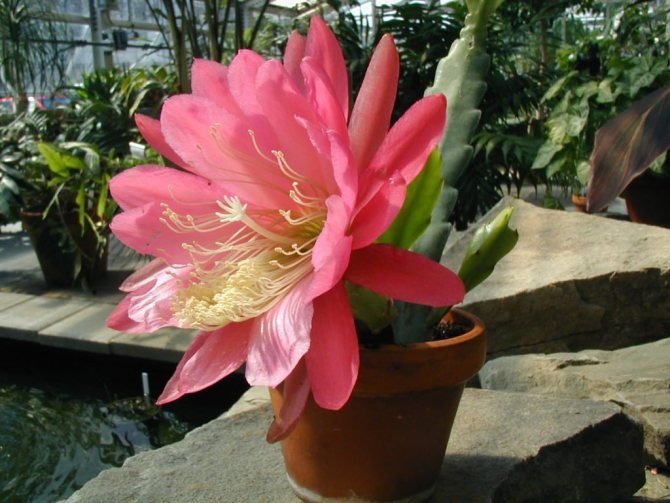

This showy pink flower is a hybrid variety of Epiphyllum Just Pru
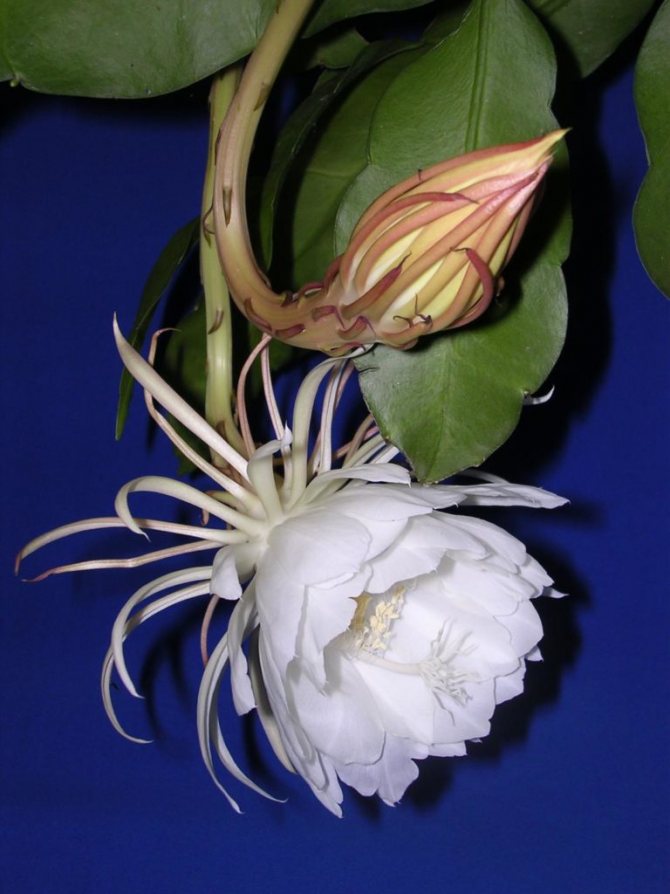

Hooker's epiphyllum has snow-white flowers


Ackerman's epiphyllum flower can be red, white, but the most beautiful is yellow
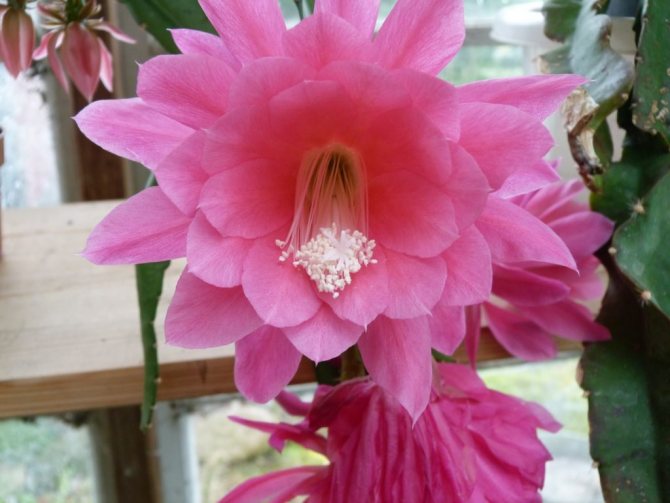

Epiphyllum phyllanthus - a large plant, but also a flower up to 18 cm
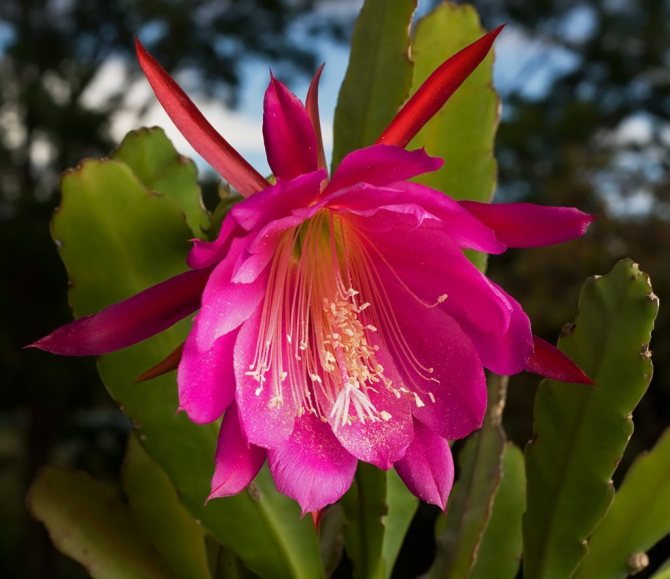

Hybrid Wendy-2 - minimum greenery and a huge flower
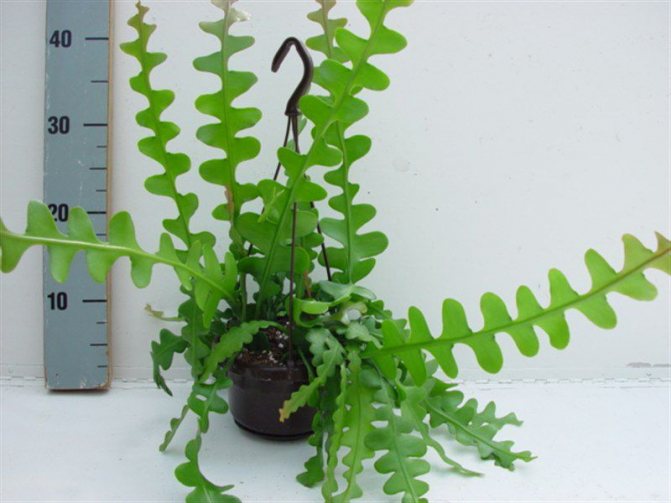

The angular ephiphyllum has a very spectacular stem shape.
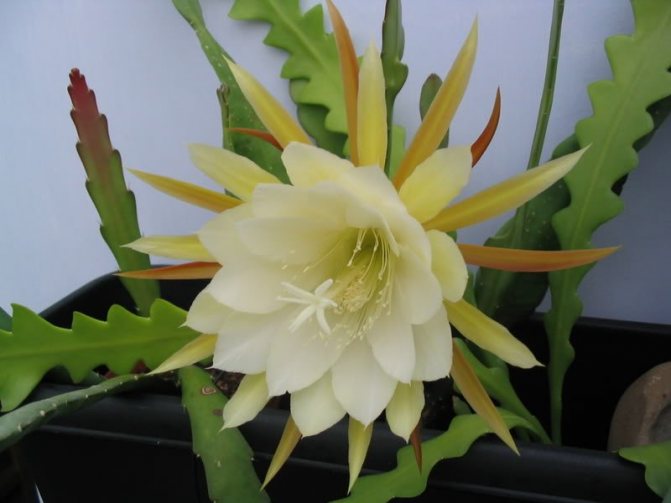

Epiphyllum serrated has serrated stems

